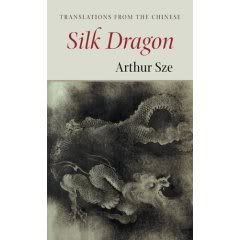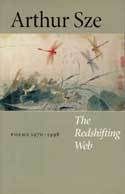His poems appear in numerous magazines, including American Poetry Review, The Paris Review, Mother Jones, Conjunctions, and the Bloomsbury Review. Translations of Sze's work have been published in Italy and China. An award-winning poet, Sze directed the Creative Writing Program at the Institute for American Indian Art in Santa Fe, New Mexico, where he taught for more than a decade. This interview was conducted for Asian American Press.
AAP: Do you have any major upcoming projects?
AS: I am currently working on my eighth book of poetry, which I hope to complete before the end of 2003. Some of the major sequences that will be incorporated into this new work include "Earthshine" and "Quipu," first published in Conjunctions. "Didyma," another long sequence will appear in the December issue of The Kenyon Review. I'm currently working on orchestrating short, discrete poems into the larger weave of the manuscript.
I am also co-editing, with Michelle Yeh at UC Davis, a feature on contemporary poetry in Taiwan for an upcoming issue of Manoa, to be published in the summer of 2003. Some of the poets who will be included are: Yang Mu, Shang Qin, Lo Fu, Luo Ying, Ling Yu, Hsia Yu, Chen Li, aboriginal poets Walis Nokan and Monaneng and many others. I'll be reading my poems and lecturing in Taiwan (in Taipei and Hua Lien) for two weeks this fall.
AAP: How would you describe your writing process?
AS: My writing process is slow and arduous. I go through many drafts--sometimes 100 or more--to arrive at a completed poem. There's a delicate balance between rigor and spontaneity, and I oftentimes have to shed or let go of what I think the poem is about or where it is headed in order to let the real poem emerge and discover what is truly essential.
In writing sequences, or extended poems, I never write the opening poem first. I usually write a section that is about half or two thirds of the way through; I then have to work backwards and forwards to discover over time the essential sequence. Most of my extended poems take about one section a month to write. "Archipelago," for instance, took me ten months to create.
AAP: What were some of the biggest challenges for you when translating the poets in The Silk Dragon?
AS: As a preface, I need to say that the translations in The Silk Dragon encompass a thirty year time span, but I did most of the translations in three bursts. In 1971-72, as a student at UC Berkeley, I turned to the T'ang masters--Li Po, Tu Fu, Wang Wei--as a form of poetic apprenticeship.
I wanted translations that were faithful to the meanings in the original Chinese but which also moved well as poems. I struggled with how to make the poems move rhythmically in English while retaining the sharp images and intensity and brevity of the originals.
In 1983-4, I did a second group of translations that included T'ao Ch'ien, Ma Chih-yuan, and Wen I-to. In these translations I struggled with how to make the voice of each poet a driving force behind the poem.
Finally in 1995-96, I worked extensively with Li Ho and Li Shang-yin. Here I wanted to struggle with poems that had many layers and allusions to Chinese history, alchemy, mythology and yet stay focused on the essential thread of longing that is woven into the tapestry of their poems.

AAP: In translating the poets in Silk Dragon, did you discover anything about your own style of writing?
AS: I know translation is an impossible task. The Italians say: traddutori/traditori: translators/traitors. Yet, I think translation can be one of the best ways a young poet can develop his or her voice.
Of all the poets I translated, Wen I-to is the crucial one for me. (Much as I admired the T'ang poets, I arrived at the point where I felt the vocabulary and compression in the 5 or 7 character line was just too constricting.)
In many ways Wen I-to deliberately broke against that elegant tradition with his breakthrough volume, Dead Water. In translating a poem such as "Miracle," I inadvertently discovered what needed to happen for a short lyric poem to extend beyond 20-30 lines.
In many ways the Wen I-to translations are the bridge between classical Chinese poetry and my own work.
After the mid 1980s, I began to write sequences of poems where I could greatly extend the range and depth of my poetic material and where I could use juxtaposition as a form of metaphor. (I believe the structure of Chinese characters oftentimes show that , linguistically, juxtaposition is used as a form of metaphor where the "is" or equal sign is omitted.
For instance, "tree tips" + "fire" = "autumn"; but the Chinese character embodies and removes the equal sign so that tree tips juxtaposed with fire creates the character autumn. If "autumn" is written above, and "heart/mind" below, then the character "sorrow" = "autumn" in "heart/mind." So some Chinese characters may contain multiple metaphors.)
AAP: What themes and ideas are particularly interesting to you in your writing these days?
AS: I'm pursuing the metaphor of language as fiber. I like a book of poems to be one large interconnected work (where a short poem has its place, and a long poem also has its respective place).
So at the moment I have poems strewn all over the floor where I'm physically moving them around and relocating them to explore the larger structure of this new book
AAP: Your work frequently creates an intersection of traditional and modern life, as well as an intersection between Eastern and Western cultures, the historical and mythic. What are some of the concerns that emerge for you as a writer?
AS: I suppose I'm trying to create an essential weave and web with my writing. Instead of linear structures and linear time, I'm more interested in harnessing synchronicity and simultaneity. My experience of the world is more like a game of go (in Chinese, isn't it called wei chi?), where an event that occurs at one particular intersection greatly affects everything else.
I titled my poems from 1970-1998 The Redshifting Web because that phrase harnesses the infinitely small and the infinitely large and also allows room for empty space. In astronomy, redshift shows that the universe is expanding (light from distant galaxies is bent toward the red end of the spectrum), whereas a web is something small that, say, a spider creates.
In looking at the poems I had written over 28 years, it seemed like an appropriate metaphor to show how the poems are related yet deepen and keep opening up.

AAP: How do you address accessibility for audiences from different cultural backgrounds?
AS: I like poems which are charged and immediate but which are also polysemous (having many meanings). I think a good poem can pull a reader into a new world, and even if, intially, a reader doesn't understand a particular word or phrase or reference (that will come later, after several readings), a reader can read by nerves and still intuit the overall effect. I do think, because we live in such a consumer-oriented surface-oriented world, poetry has a crucial role to play.
It asks us to slow down, to experience the sounds and rhythms and silences of words, to re-experience and re-envision the world. In doing so, in go deeper into ourselves, I hope it is a rewarding request to ask a reader to look up a new word or even look up a familiar word to look at its etymology etc. All of the worlds are coming together, and I think it's important we learn from each of the traditions that is evolving.
In terms of my own poetry, there are instances where I need to use a word from a certain language (it can't be adequately translated), yet I'll try to provide enough reference in English to make it more accessible.
For instance, in a poem called "Parallax," I open with: "Kwakwha."/ "Askwali." I don't expect a reader to understand these words. I prefer a reader to hear the sounds and be astonished by them. (What are they? What do they mean?) In the next line, I clarify the meaning with. "The shift in Hopi when a man or woman says 'thank you' ..." So I make clear to a reader that they have just heard two words from the Hopi language which are two gender different words for saying "thank you."
So I try to stretch and yet maintain a form of balance.
No comments:
Post a Comment